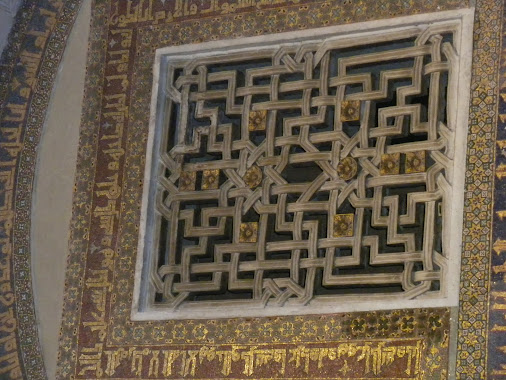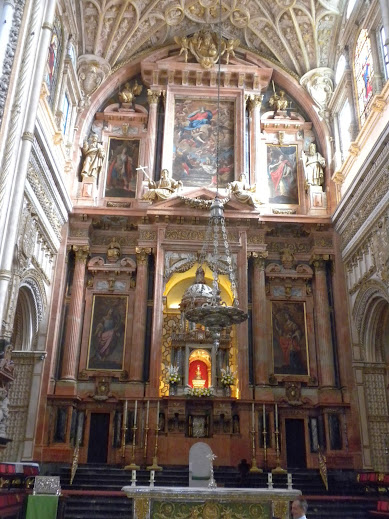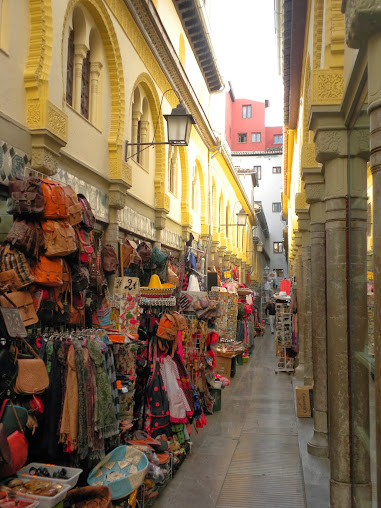Carol
writes:
CORDOBA:
So far our travels throughout Western Europe had taken us from one
splendid cathedral/basilica to another.
Most of these churches have been airy Gothic marvels with incredibly
high vaulted ceilings and wondrous stained glass windows. In Spain we were looking forward to seeing a
very different architectural style dating from the era of Islamic medieval Spain. The city of Cordoba was the capital and crown
jewel of Arabic Andalusia, the region in southern Spain where the culture of
the Arabs met the great western thinkers of the day. Aristotle was widely read and much admired by
Cordoba’s Islamic thinkers. For a time, Christianity
and Islam actually existed peacefully side-by-side until the activism of the
Crusades began.
Our first
destination for the day in Cordoba was the medieval wonder of ‘The Mezquita’—Islamic Cordoba in
prime-time condition. The Mezquita
complex was the location of a massive former mosque that subsequently had a 16th
century Christian church built right in the middle of it. The Mezquita walking tour began in a pleasant
courtyard.
As soon as
we entered the dimly lighted area of the former mosque, we were dazzled by a repeating
display of red and white striped arches.
The most
sacred area of the mosque was the mihrab,
not much more than a little niche-like area where the prayer leader would stand to read scripture or give a sermon.
Since Islamic
art forbids the use of the human form, all of the artistic decoration in the
mosque section was abstract design. Many
of these fascinated my quilter’s eye, especially the ones with continuous line
designs. Some of these may become
inspirations for future quilting projects.
On entering
the cathedral area of the mosque, we were suddenly thrust into an entirely different
ecclesiastical world.
Exiting ‘The
Meziquita’ brought us back out into a brilliant sunny day. We were fortunate to get one of our rare
twosome pics on Cordoba’s ancient Roman bridge.
It was heavenly to have a day in which we could get by in short sleeves
and no jackets!
We savored
the rest of our day with a stroll through the narrow streets of Cordoba,
first
through the Jewish Quarter, where we paused to admire the statue of Maimonides,
who lived in Cordoba and was one of the greatest Jewish thinkers of all time.
We had a quick
peek into an ancient Jewish synagogue,
then finished
off our day with a little sangria
at an
outdoor café just inside the ancient city walls of Cordoba.
GRANADA: Perhaps the grandest expression of the Moorish kingdom in
Spain is found in the foothills of Granada at Alhambra, the greatest Moorish
palace in all of Europe. We spent the
first day in Granada doing a “get familiar with the lay of the land” walk. We passed through an area that once was a
Moorish silk market but now was host to numerous colorful vendor stalls selling
all the popular trinkets of the day.
We visited
the ‘Royal Chapel’ where we gave a nod of thanks before the grandiose Carrara
marble tomb display of King Ferdinand and Queen Isabella, who were the Spanish
king and queen who financed the voyage of Christopher Columbus. What was most unusual was the viewing of the
simple, unadorned coffins of Ferdinand and Isabella, just beneath the lavish tomb
display.
To visit Alhambra the next day, we had to jump through a few hoops to reserve a timed entry, but our campground host offered to do the reservation online for us, plus order a taxi to take us directly up the hill to Alhambra the next morning, so the planning of our visit was greatly simplified.
To visit Alhambra the next day, we had to jump through a few hoops to reserve a timed entry, but our campground host offered to do the reservation online for us, plus order a taxi to take us directly up the hill to Alhambra the next morning, so the planning of our visit was greatly simplified.
The entire
Alhambra complex was composed of four venues:
The Gardens, the unfinished Palace of Charles V, the fort, and the royal
palace itself (the Palacios Nazaries).
Since we had an early afternoon timed visit for the palace, in the
morning we started our visit to Alhambra in the lovely palace gardens, where it
was impossible to take a bad picture.
We visited
the unfinished palace of Charles V,
then
continued on to the fort complex, where we got the most eye-popping views of
Granada below and, in another direction, a snowcapped peak in the distance!
Our last
venue for the day was the Alhambra palace itself—what we had been waiting all
day to see…
How to
describe Alhambra? For starters, it was
a glorious feast for the eyes. It seemed
like every square inch of the walls, floors and ceilings were decorated with
either tiles, stucco, carved wood, or molded plaster. In keeping with Islamic beliefs, all designs
were abstract and did not reflect any human forms.


From an
historical perspective, the largest room (the Grand Hall) held a unique fascination
because that was the very room where Christopher Columbus made his request to
King Ferdinand and Queen Isabella to finance his voyage to the Orient.
The
Courtyard of the Lions was even more interesting to me when I learned that the circular
fountain of 12 lions once functioned as a clock with a different lion spouting
water each hour. How clever!
The laciness
of the stalactite-type plaster ceilings was hard to capture with a camera lens.
Finally, the
best view of Granada from the palace was from the balcony off the room where
Washington Irving stayed in 1829 and wrote “Tales
of the Alhambra.”
We were
quite thrilled with our visits to both Cordoba and Granada, with their captivating
Moorish ambience. In our drive throughout
all of Andalusia, the beauty of the sparkling white hill towns was
breathtaking. However, those snow-dusted
peaks that we saw in the distance from ‘The Alhambra’ reminded us that Fall was
making its relentless march into Winter.
Our plan to keep winter at bay as long as possible meant that our driving
route the next day would be directly south to Spain’s famous fun-in-the-sun
coast called the Costa del Sol. We
wondered if the endless high-rise condo sprawl on the Costa del Sol would be as
bad as we had read. We also debated with
ourselves if we should make the effort to negotiate a day trip into Gibraltar…
“Do not weep like a woman for what
you could not defend like a man.” Said
by mother of last Moorish king as he fled Alhambra




























No comments:
Post a Comment